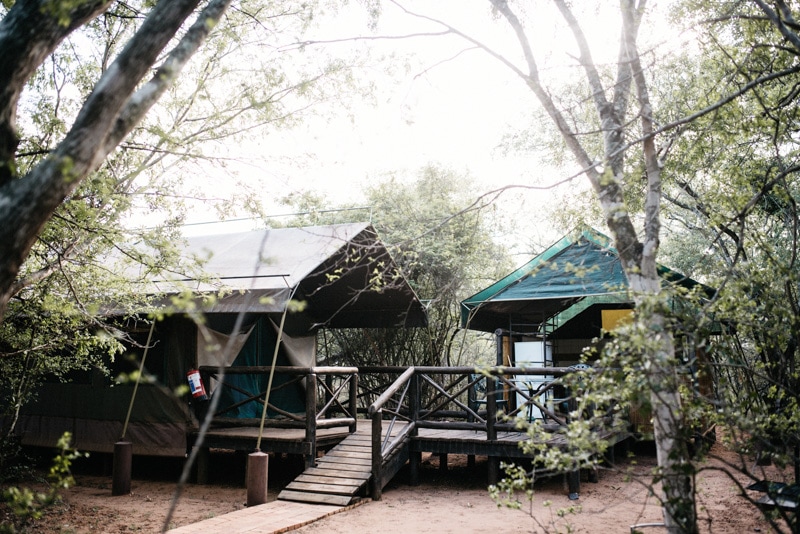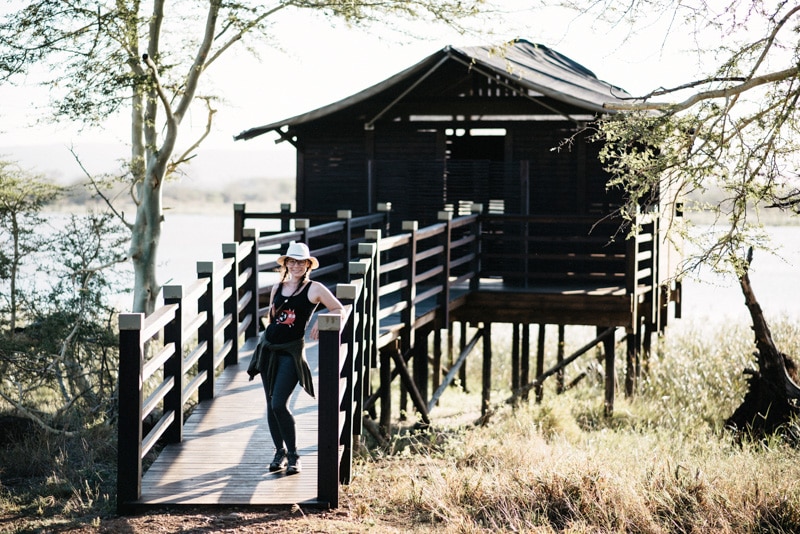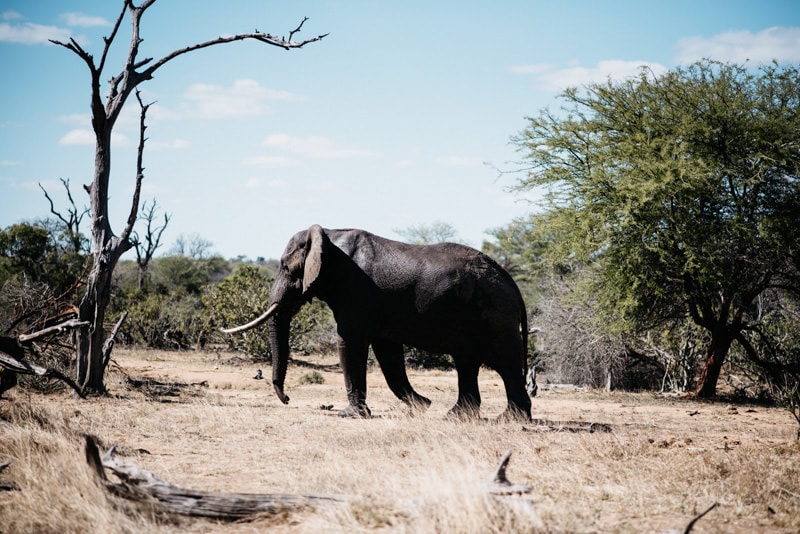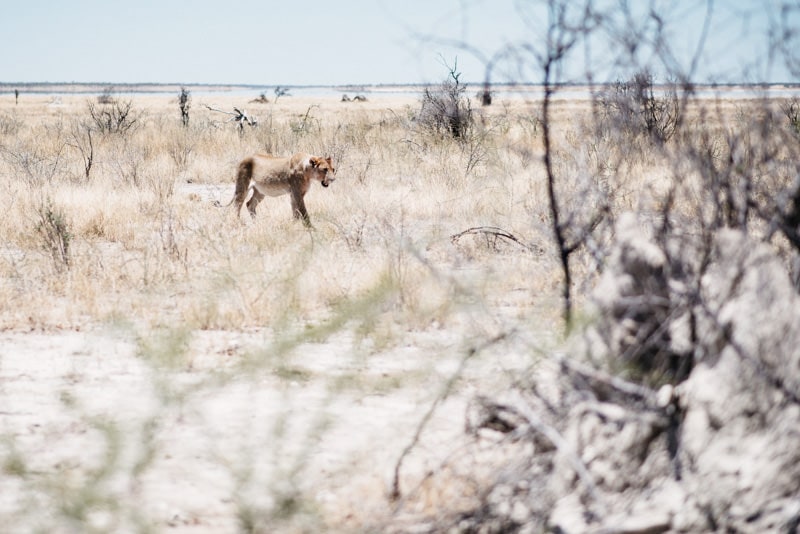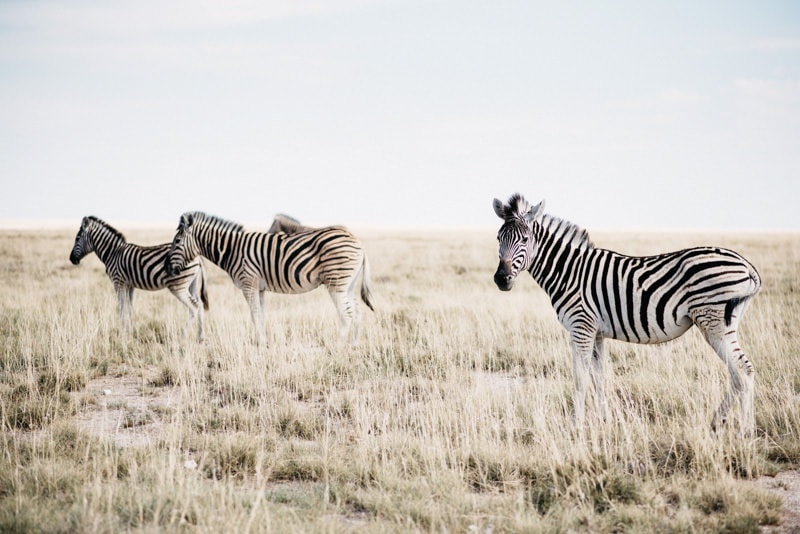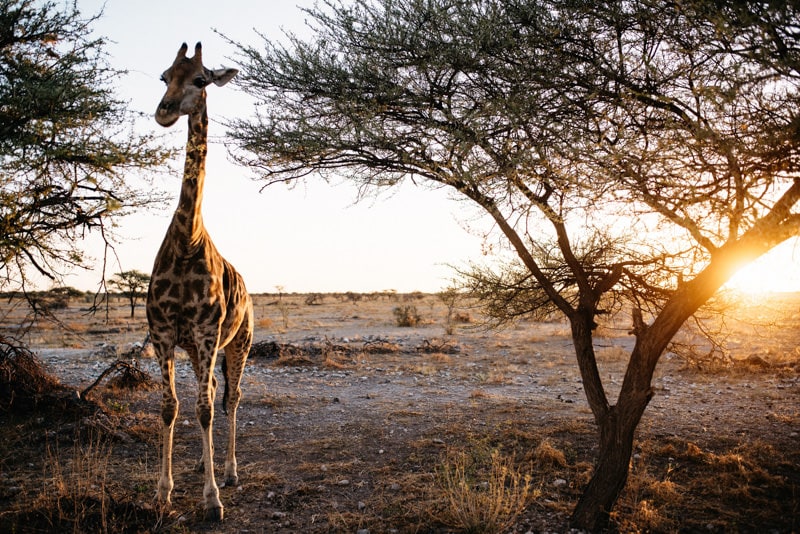We decided to visit two National Parks in South Africa – iSimangaliso Wetland Park and Kruger National Park. Our goal was clear – spotting as many animals as possible. Of course, we hoped to see all of the Big Five, but you cannot plan this – you can just go on safari and see what happens. In Africa, the lion, leopard, rhinoceros, African elephant and the African buffalo are considered the Big Five. The term comes from the field of wildlife hunting and was just adopted by tourism for marketing. In hunting, the Big Five are the animals that are most difficult and dangerous to hunt.
iSimangaliso Wetland Park
On our way from Durban to Kruger National Park, we spent two nights in iSimangaliso Wetland Park. We rent a Safari Tent at Camp Mantuma (inside the UMkhuze Game Reserve), which was a partly painful experience – but more to that later. We were really lucky because right after we had entered the Game Reserve, giraffes crossed the street. It was an amazing experience, much better than the zoo. We watched them eat from the tree for a little while before we continued to the camp. After we had checked in to our tent and accepted that our domicile for the next two nights was a tent in the middle of the jungle, which even in closed condition had a little hole in the “door” – just big enough to fit a small animal, we started our first game self-drive. We quickly found out that we are talented animal spotters because we saw zebras, more giraffes, monkey, impalas and buffalos.
[Best_Wordpress_Gallery id=”40″ gal_title=”UMkhuze Game Reserve”]
The worst night of our tour so far – well, in our lives
After our little drive we were totally tired and ready for a good sleep. Bad for us that we were complete safari tent in the jungle-newcomers because this made us leave our food bag on the floor. After not even two hours of sleep, Bianca woke up from a sound, that she thought was an animal trying to enter the tent. She was sure she had just dreamt, when she heard the sound again. This time she was sure the animal had succeeded and entered the tent and when, after a minute the food bag started to rustle, she knew her nightmare had come true. Bianca is a very creative mind with a huge imagination and as she had not heard the animal walking from the tent entrance to the bag, it just had to be a footless animal. Counting one and one together brought her to the conclusion that it can only be a cobra or a black mamba. What to do in this situation – of course, wake up Tom to defend our territory and show the animal who is the boss. While Bianca was concerned with panicking – well, not too bad but according to her just as much as every female that likes pink would have panicked – Tom turned on the light, armed himself with a tripod and chased the intruder away. According to the hole in the bag it was a mouse – but it could really have been everything. It was the worst night for Bianca, the second night we had to leave the light on the entire night because she is convinced (and she still is) that animals are comparable to burglars – when they see that there is light they assume you are “at home” and won’t come in.
11 Hours until Kruger
The next day, we went to a lake close to our camp to watch hippos, which turned out to be completely boring animals. Bianca has this inexplicable passion for lazy animals lying in the water all day long doing basically nothing – so we had to go there. Her favorite animal in the world is the Capybara – an oversized guinea pig that is mostly lazy and looks totally cute. The hippo is the same to her – cute, lazy and in the water. So, perfect to go and watch. We quickly discovered them in the water, but really just the very top of them was above. And we sat there for about 45 minutes – nothing happened. After one had eventually opened his mouth, which looked very cool, Bianca’s excitement had changed to disappointment because of too much laziness of the animal, so we left. In the evening, we participated in a night game drive. We drove through the reserve for 2 hours in one of these huge safari cars (according to Bianca just like in Disney World’s Animal Kingdom) and spotted animals with huge flashlights. Observing the jungle at night is an interesting experience, you get to see a world you normally just hear. We saw birds, giraffes, zebras, impalas, buffalos and many many rabbits. A night game drive is not the most exciting thing on earth but, at least according to Bianca, a highly meditative and soothing experience. Tom fell asleep at the end, so for him it was more sedative.
The next morning, we continued our journey to our lodge close to Kruger National Park – the last highlight of our tour through South Africa. It was a rather exhausting 11-hour drive but when we arrived there, our world was just perfect. We stayed in the African Rock Lodge in Hoedspruit, about 70 kilometers (43 miles) from the Orpen Gate to Kruger National Park and about 1,5 hours drive to the God’s Window, the first viewpoint along the Blyde River Canyon.
Blyde River Canyon
On our first day in the Kruger area we did the Panorama Route. It is a scenic drive that also leads along the famous Blyde River Canyon. It starts in the village Graskop and can easily be covered in one day, the last stop being the viewpoint Three Rondavels. The route is about 50 kilometers (31 miles) long and has many diverse viewpoints.
The Blyde River Canyon (named after the Blyde River flowing through) is considered one of the big natural wonders in Africa. It starts right after the viewpoint Bourke’s Luck Potholes. The canyon is 26 kilometers (16 miles) long and has reaches maximum depth of 800 meters (2.600 ft). It mainly consists of red sandstone, which looks really stunning in the sunlight. Because of its sub-tropical afforestation, it is the greenest canyon in the word. It is a rather touristic hotspot – we saw lots of busses along the road, the viewpoints were pretty crowded and they all have a good coverage of souvenir stands.
We started our tour in Graskop which is not far from the first – and probably the most famous, however not the most spectacular – viewpoint: God’s Window. It offers a splendid view 900 meters (2.952 ft) down to the Lowveld – a green plain full of lush forests. The next two viewpoints are the Lisbon and the Berlin Falls. Because of erosion throughout the history many waterfalls came into existence, the Lisbon and Berlin Falls being two of them. After the Berlin Falls, it was time for a little break – our lodge owner told us a secret, the Potluck Boskombuis. This is a real secret, not very crowded and just a short dirt road off the main panorama route. It is a nice little restaurant that serves typical African dishes and is located directly on a river. After a refreshment and a little photo session, we continued towards the next viewpoint: Bourke’s Luck Potholes. Little bridges were built to enable tourists to cross the geological phenomenon that was formed by rapidly rushing water eroding numerous cylindrical potholes. Little waterfalls and plunge pools can also be found at the site that is really worth visiting. The last viewpoint is by far the most spectacular. The Three Rondavels are three round and grass-covered mountain tops with pointed peaks. They remind on the typical African houses and are really impressive to look at. This is also the point where you get to admire the canyon with its red-green-yellowish coloring and its entire size the best.
[Best_Wordpress_Gallery id=”41″ gal_title=”Blyde River Canyon”]
Entrance Fees
At every viewpoint you have to pay an entrance fee, so it is good if you also bring smaller change.
God’s Window: 15 Rand (90 Cent) / person
Lisbon Falls: 10 Rand (60 Cent) / car
Berlin Falls: 10 Rand (60 Cent) / person
Bourke’s Luck Potholes: 55 Rand (3,50 EUR) / person
Three Rondavels: 25 Rand (1,50 EUR) / person
We did not cover the viewpoint The Pinnacle and Blyde River Canyon as our lodge owner told us the others were the most spectacular.
Looking for the Big Five – Safari in Kruger National Park
In our guesthouse, we had booked a one-day safari in Kruger National Park. As we, in the meanwhile, were aware of the fact that we are rather lucky than talented animal spotters, we decided to visit Kruger National Park with a tour guide. It is really easy to drive through Kruger individually with a rental car – however, spotting the animals can be tough, especially the cats are rather difficult to see even if they are there. Many tourists do it individually but we were really glad we decided to go with a tour.
Our day started very early in the morning. At 5:00 AM our tour guide Shoes (yes, he is really called shoes – Bianca, of course, thinks it is the perfect name) picked us up at our lodge with his open Toyota Hilux Safari car. The drive to the closest gate from our lodge – Orpen Gate – took about an hour. It was good that there were blankets in the car because it was really cold and windy. After a short coffee stop right after the gate, the safari experience started. We quickly spotted Impalas (they are really easy to spot – Shoes said if we had not seen Impalas by the end of the day, we would get another full day safari for free), buffalos, many colorful birds and a lonely wildebeest. All of a sudden, there was an elephant enjoying his breakfast right next to the street – the first highlight of the day and it was not even 8:00 AM – super exciting! Watching animals at the zoo is not in any world comparable to seeing them in nature and observing their behavior. We learnt a lot about the animals from our guide Shoes. He is the coolest guy you could get as a guide – he grew up in the bush, knows everything about animals and shows the deepest respect for them and their behavior. His philosophy is to not only spot the animals and show them to the tourists – his goal is to really teach people and have them learn everything about the nature and the circle of life. It was great to observe the animals’ natural behavior and understand why they do certain things.
After the elephant, we drove to a point where Shoes expected lions. As we approached the spot, he was already celebrating his ability to smell lions, we were just puzzled because we saw a few zebras, a gnu, monkeys and lots of dry grass and trees but, by far, no lion. Apart from seeing the lions, Shoes told us that we can observe a clear sign there’s gotta be something – namely, the zebras and the gnu obviously being highly attentive and all looking into the same direction. They were still in their comfort zone, watching the enemy from a safe distance. After a little while, we also discovered the lion lady relaxing in the grass after a hard night out hunting – through the binoculars because it was too far away to see it without. Contrary to what we had concluded from the “Lion King”, we learnt that the lion is not at the very top of the hierarchy of all animals, there is no animal at the very top. Hierarchies do only exist among animals of the same species. After we had spotted a group of other females lying under a tree, we continued our drive. Soon, a herd of zebras crossed our way and all females in the car were completely excited. For some reason, women perceive zebras as especially aesthetic and beautiful – Bianca already thought so in iSimangaliso Wetland Park and our female safari-buddies confirmed her point of view.
After the street was free again, we soon reached a waterhole and finally, were able to clearly spot hippos, taking their daily hourly-long refreshing bath. We were really lucky because two of them were bathing with their babies – that were, according to Shoes, only a few months old. It was definitely one of the best days in Bianca’s life as one mum was eating outside the water with her baby and therefore, she could see a whole hippo. Then we had to quickly continue because Shoes had just learnt from another guide, that he had spotted a cheetah nearby. Shoes saw it quickly with his laser-like eyes, we, by contrast, again couldn’t see anything. After he told us exactly where to look, we also discovered it – very cool stuff. We continued our drive back to the waterhole, spotting giraffes on the way. They had made themselves comfortable under a tree eating and enjoying the shadow.
Just by that time we passed the waterhole again, an elephant dad had also arrived with his baby striving for a little cool down. The real young ones can be recognized easily because they are still hairy. They were really cute to observe soaking in water and spraying it on themselves. After a long and pretty successful day on safari, it was already time to start the return travel to our wonderful lodge. On our way to the gate, we saw pumbas (warthogs) and monkeys and were totally happy about the day. Shoes was not completely satisfied as we had spotted only three of the Big Five: lions, elephants and buffalos. The leopard is very hard to see but he didn’t want to leave Kruger that day without showing us a rhino. We had just left the gate, when he suddenly fully braked the car. It was the perfect ending of the day because there were two rhinos right next to the street. Everything worked out perfectly that day. The thing with safaris is that you never know what to expect, you can be really lucky and spot a lot of animals and you can be less lucky and only spot a few or even none.
[Best_Wordpress_Gallery id=”42″ gal_title=”Kruger”]
A compact guide to animal knowledge
We tour the World featuring Shoes’ knowledge of animal kingdom:
African Elephant
This is the largest and heaviest land animal on earth – and it has to work hard for that. The elephant spends approximately 18 hours a day eating 250 kilograms (550 lbs) of greens like trees and grass and drinking up to 200 liters of water. They have huge ears that they are almost uninterruptedly waving. We thought it was cute to watch but Shoes told us that they do it to cool their body down. The skin of the elephant is very thick which basically causes their inability to sweat. So, they cool down with their ears and by soaking in water and mud in their trunk and spraying it on themselves. Very funny to watch! The male elephants usually live alone, females, on the opposite, in herds with the babies. Males approach the females only for mating – females make sounds when they are ready. Unlike other species, there is no specific mating season and they carry for 22 months before the babies are born. Usually they have one baby at a time but twins have already been reported in Kruger (very little though).
Hippo
The hippo is the third-largest land mammal after the elephant and the rhino. Although they remind much more on pigs than fish, they are related to aquatic mammals such as dolphins and whales. They spend almost the entire day cooling down in the water of lakes, rivers and waterholes. They are usually almost entirely under water and have to breathe only every 9 minutes. They can sleep under water and don’t have to wake up to breathe – it is like humans who don’t stop to breath just because they are sleeping. At night, they leave the water in order to eat for some hours – they consume mainly grass and can eat up to 70 kilograms (155 lbs) at a time. Hippos are not real social animals, they lie together but do not form real social bonds.
Lion
The lion is the second largest living cat – the largest being the tiger. Lions are very social animals and usually occur in prides. A pride consists of related females and their little Simbas and Nalas as well as a smaller number of males. Both males and females can hunt but males are the better-suited hunters because of their powerful appearance. They attack quickly and very powerful and usually eat right where they killed the prey. An adult lion needs approximately 5 kilograms (11 lbs) of meat per day, competing for prey with hyenas in areas where they co-exist. As elephants, lions do not have a specific mating season. When in heat, females may mate with more than one male, giving birth to the cubs after 3,5 months.
Zebra
The zebra is a relative of the horse and characterized by the white-black stripe patterns, each being individual. Zebras are extraordinarily social animals and most of the time occur in herds. They eat primarily grass and sleep standing up and only when other animals are around securing the area of predators.
Giraffe
Giraffes are the tallest living animal on earth. Related females live together in herds, that can change over time, with their kids. Before reaching sexual maturity, males live in casual associations, then turning into solitary animals. Most of the day, giraffes are concerned with eating from trees and ruminating. Their most specific characteristic is their neck, that only consists of 7 cervical vertebras. Male animals tend to use their neck as weapons when fighting, that is called “necking”. Giraffes never lie their head down on the ground – not even for the purpose of sleeping. The reason is that it will hardly be able to get up again. Furthermore, the head always needs to be up for the purpose of blood circulation. When the head is down, blood cannot circulate very well and the giraffe can die within a few minutes.
Rhino
Adult rhinos have no predators in the nature, their only threat are humans. Rhinos are hunted by humans for their horns – even in Kruger this is still a problem. Rhinos do typically occur alone, sometimes in little groups. During the day, they usually sleep or pursue non-exhausting activities like chilling. At night, they are concerned with eating. They only eat vegetables such as leaves, branches, buds and fruit.
What we learnt in Kruger
- If elephants were able to fly, they could kill you from above with only one piece of their shit.
- Elephants don’t run, they just make big steps – reaching up to 40 kmh (24 mph).
- Cats are the hardest to spot – even if your guide says they are there, you will have a hard time seeing them.
- Zebras are not white and black – the white actually tends to be more of a brownish color.
- Giraffes are not yellow as we always used to color them when we were still little. They are more ivory.
- If a giraffe puts her head on the floor it is likely to die.
- Bianca didn’t see a rainbow anywhere close – so a rhino is not a unicorn.
- The only animal that considers humans as food is the crocodile.
Kruger National Park Safari Hacks for Individual Travellers
- Bring a binoculars
- Aiming at taking pictures of cats, you should bring a good telephoto lens (at least 70-200 mm or even more)
- If there are many safari cars gathering at one spot, stop and ask them to tell what they spotted and where you can find it – they are very friendly and will gladly help you
- Wear clothes that are natural colored
- Never block the way of an animal with your car – they will change direction and back off
- Never provoke animals – watch them, take picture but respect their comfort zone
- If you go to Kruger you don’t need to necessarily take malaria prevention pills (they are expensive and strong antibiotics) but bring a good mosquito spray.
Tour Operator & Accommodation at Kruger
Shoes was really the best guide and we spent an awesome time in Kruger with him. We can highly recommend him as a guide, he is educating and entertaining. He answered all our questions, gave us a deep insight into the life and behavior of animals. He also educated us about the dangers of wildlife and how you can easily avoid making their acquaintance (such as getting bitten by a snake which is seemingly the most unlikely event, getting attacked by a lion which is seemingly as unlikely as getting biten by a snake, etc …). He taught us that surviving in the bush is all about respecting wildlife, their habits and comfort zones. Shoes offers Safari Packages, guided bush walks as well as guided day drives in Kruger – so you got the choice.
Price for a day safari: varies according to the number of participants (we were a party of six and paid 1.400 Rand (appr. 85 EUR) / person.
Includes:
- Guided Game Drive
- Pick-Up from and drop-off at your accommodation
We stayed 4 nights at African Rock Lodge in the Hoedspruit Wildlife Reserve. It is located about an hour drive from the closest gate of Kruger National Park (Orpen Gate) and about 1,5 hours drive from Graskoop (the beginning of Panorama Route). We did not want to spent 300 Euros or more for one night in a private game reserve or any upscale lodge in or close to Kruger, so we booked the African Rock Lodge, which turned out to be the best decision ever.
All our expectations were completely exceeded by the owners Sander and Juliette. The logde is perfectly located in a gated wildlife reserve and is super-nice. It has a pool, a nice patio where you can sit and eat outside and a huge grill where Sander prepares the best Braai every night (250 Rand / 15 EUR /person). The rooms are super sweet with African style decoration everywhere. The bathroom is very spacious and accommodates a shower and a bathtub. In every room, there is a minibar and complimentary coffee, tea and Sherry. We loved the sherry and enjoyed it every night before we went to bed. The overnight stay includes breakfast – which is really the perfect start into the day. It fulfills every culinary need – toast, cheese, salami (real, tasty salami), ham, cereals, yoghurt, Nutella and, if that wasn’t enough already, Juliet’s homemade cinnamon muffins (fluffy as a cloud) and warm pancakes.
The Braai is just as heavenly as the breakfast. Sander has new kinds of meats on the grill every night and so we got to try typical African specialties such as Kudu, Ostrich and Impala. The dinner also includes a desert – we could choose between homemade icecream, cake (Bianca was out of her mind because one of the little things she misses is the one or other good piece of cake) and Amarula San Pedro (a vanilla ice cream – Amarula shake). They are also very responsive to special requests – Bianca told them she cannot eat onions and fruit. Her desert was the only one that did not have a strawberry for decoration and they even prepared onion-free potato salad just for her.
They even have a turndown service – when you come back to your room after dinner, your bed is already prepared and a little chocolate is waiting at the top of your cushion.
They also organize Safaris in the Kruger and inform you about the Panorama Route (have lots of tipps on how to do not miss anything) as well as activities in the close surroundings of Hoedspruit.
It was the best we have ever experienced – you can feel their love for hospitality and what they do in every little detail they deliver. There is just one word for the experience: unbeatable.

